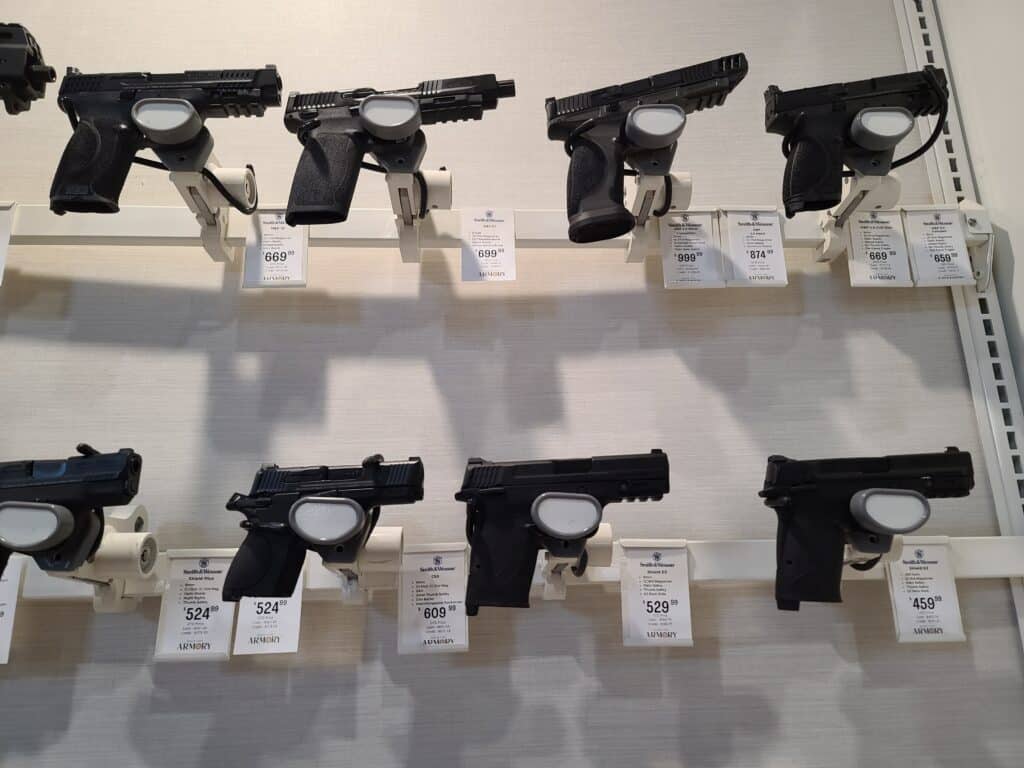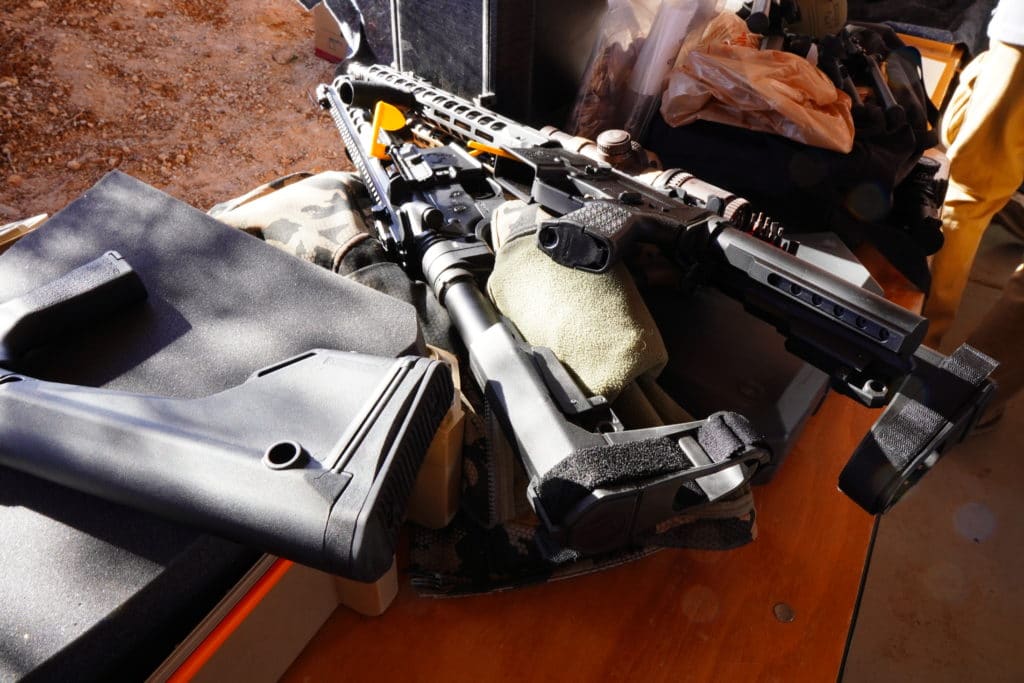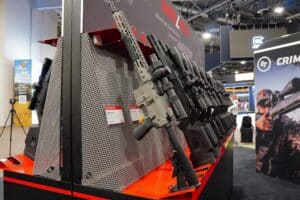I remember watching an episode of Mr. Robot a few years back and enjoying the experience until an unrealistic turn took me out of it. This would become a more and more common feeling watching the show as the show wore on and drifted further from a coherent narrative.
But the problem with a scene in Season 2 Episode 12 is relevant to the topic of today’s newsletter. As an FBI agent is tracking down a lead on the hack of “Evil Corp” (the show was never terribly subtle), she told a suspect they had found a shell casing at the scene of a crime they believed came from his gun. That’s not so unrealistic, but the method for IDing the gun was: microstamping.
The problem with this little line of dialog, which I was not alone in noticing, is that microstamping is not something that exists. It is a purely theoretical technology. No manufacturer anywhere in the world produces a gun that has microstamping, and nobody ever has.
That’s despite California mandating all new handguns include the tech, which is why you can’t buy a new pistol model developed in the past 10 years. And it’s a big reason why the law has recently been found unconstitutional. None of that has deterred New York and New Jersey from pursuing the same path.
However, as Contributing Writer Jake Fogleman explains, they seem to have run into some issues.
Meanwhile, Congress has taken action to undo President Biden’s pistol-brace ban. I go over why that action is likely to get further than you might expect and why the lawsuits against the ban are still the better bet to see it repealed.
Plus, Biofire founder Kai Kloepfer joins the podcast to answer questions about his new “smart gun.” And I detail my recent troubles in getting my DC concealed carry license.

Analysis: New York and New Jersey Go On a Microstamping Snipe Hunt [Member Exclusive]
By Jake Fogleman
New York and New Jersey are attempting to join California on its quixotic project to make microstamping a reality. It’s not going well.
On Thursday, Politico reported that the New Jersey Attorney General’s Office is five months behind on its statutory deadline to determine the “technological viability” of microstamping in guns.
“Work on the microstamping regulations and investigation is proceeding and will be completed as soon as possible,” Michael Symons, an AG spokesperson, told the outlet. “Every effort has been made to implement the microstamping law as quickly as possible and much of the work necessary to reach that goal has been completed. This includes reviewing the viability of the technology, which is currently underway.”
That report comes after Gothamist first reported the Empire State was having the same exact issues with its own recently-passed microstamping requirement.
“A New York state law requiring microstamping capability in new pistols is already five months behind schedule, with final results from a required study of the technology not expected until later this year,” the outlet reported.
The state’s Division of Criminal Justice Services (DCJS), the agency tasked with certifying the technological viability of microstamping, was supposed to conclude by December of last year. Six months later, the agency is struggling to fulfill its obligation.
“To date, this working group has compiled and reviewed scientific materials, held discussions with various stakeholders, and requested additional information,” Janine Kava, a DCJS spokesperson, told the site. “However, given the scope of the inquiry and the volume of data to review, DCJS is continuing to determine whether such technology is viable.”
The lack of progress from both states is unsurprising. Microstamping, as imagined by policymakers, simply does not exist as a commercially viable technology.
In theory, the technology would function by using one or more parts of the internals of a firearm to imprint a unique, identifiable code on spent ammunition to aid law enforcement investigations. In practice, no commercial gun produced anywhere in the world has implemented it. That includes places like Europe, a continent with no shortage of firearms manufacturers and a political culture far more receptive to gun regulations than typically found in America.
Of course, New York and New Jersey need not look to Europe for flashing warning signs. They could look west to the state that pioneered the microstamping mandate.
California first passed its microstamping law in 2007 but did not enforce the mandate until 2013. That’s when then-Attorney General Kamala Harris (D.) decided that microstamping technology was “available to more than one manufacturer unencumbered by any patent restrictions.” In other words, a lack of encumbrance by patent law, not any demonstration of commercial feasibility, was enough for the state of California to ban the retail sale of handguns without microstamping.
As a result, no new firearms have been added to California’s roster of handguns considered “safe” for legal sale since 2013, functionally banning modern handgun sales in the state. Although, police officers in the state are exempt from microstamping and other “safety” requirements tied to the roster.
Some supporters of microstamping have charged that the experience in California is the result of obstinate gun manufacturers refusing to include the technology rather than an indictment of the technology itself. However, even the most safety-oriented gun companies have echoed the complaints about its unworkability.
Kai Kloepfer, founder of the new biometric “smart gun” company Biofire, told The Reload his firm is unable to incorporate any form of microstamping in its designs. That’s despite his product being self-evidently tailored toward gun safety and his willingness to produce a version of its gun that includes a loaded chamber indicator and magazine disconnect mechanism—requirements unique to California’s handgun roster.
“Biofire does not have microstamping in it,” Kloepfer told The Reload. “Similar to every other manufacturer, we have not seen a viable approach there.”
It’s a restriction that proved onerous enough to catch the attention of District Judge Cormac Carney, who issued a preliminary injunction against California’s handgun roster law earlier this March.
“Californians have the constitutional right to acquire and use state-of-the-art handguns to protect themselves,” Carney wrote in his decision. “They should not be forced to settle for decade-old models of handguns to ensure that they remain safe inside or outside the home.”
The government of California seemed to agree, at least tacitly, with Judge Carney’s characterization of its mandate as likely unconstitutional. The state requested, and was granted, a stay on the injunction regarding some of its handgun safety requirements—but did not contest the microstamping verdict. As such, microstamping remains judicially blocked while the state fights the order in the Ninth Circuit Court of Appeals.
The statute directing the research of the New Jersey AG’s office was signed into law last July by Governor Phil Murphy (D.). Upon his signature, it put the Attorney General on a 180-day clock to determine if microstamping is technologically viable, at which point all firearms retailers in the state would be required to make at least one model of microstamping-equipped firearm available for purchase as part of their regular inventory. In this sense, it is far less stringent than California’s requirement and is more akin to New Jersey’s current iteration of its “smart gun” mandate.
On the other hand, New York chose to go further than the California approach in its attempt to bring the technology to the northeast, thanks to a law signed by Governor Kathy Hochul (D.) last June. Should the state’s DCJS certify it as viable, a four-year clock will start before its full mandate takes effect. At that point, any new semiautomatic handgun sold in the state must be equipped with microstamping technology. Retailers who continued to sell non-microstamping-equipped pistols after that date would be subject to fines or even misdemeanor criminal charges upon multiple violations.
What will come of the research being done into microstamping technology in New York and New Jersey remains to be seen. Given the recent media coverage highlighting their delayed rollouts and gauging the sense of urgency expressed by the public comments provided by each state’s government officials, it’s quite likely that, at the very least, the pair of states will unveil a verdict soon.
It’s difficult to see how the technology is ready for prime time, something every current and would-be handgun owner in California already knows all too well. But the political incentives of New York and New Jersey being what they are, don’t be surprised to see a green light given based on a tendentious reading of the evidence. An injunction issued against a gun-control law in a like-minded state has never tended to stop these same states from eventually copying it on their own books anyway.
Gun-rights groups will inevitably sue, adding to the growing list of gun laws New York and New Jersey will have to defend in court. The game of cat and mouse between state policymakers and gun-rights plaintiffs will continue apace.
Come on the Podcast
One of the many perks of a Reload membership is the opportunity to appear on the podcast. We’ve had a lot of people on the show from all kinds of backgrounds. It’s one of my favorite segments since it gives us all a better insight into the community that makes this publication possible. If you want to come on the show, just reply to this email and let me know!
Podcast: Biofire Founder Kai Kloepfer Answers Questions About His New ‘Smart Gun’ [Member Early Access]
By Stephen Gutowski
This week, we’re joined by the man behind the first “smart gun” that’s going to come to market.
Kai Kloepfer is the founder of Biofire, a company that has been getting a lot of attention since announcing it will ship a 9mm pistol with integrated biometric locks this year. He answered a wide array of different questions on smart guns and the Biofire model in particular.
He explained how Biofire intertwines the operation of the firing mechanism with biometrics. Instead of using an electronic device to block a traditional trigger setup, they have eliminated the traditional system to substitute it with a fire-by-wire system. He said that was the only way they found to make the gun lock and unlock quickly enough to be useful for home defense.
He also talked at length about how the company has worked to make the gun reliable–a key consideration for most gun owners that will likely determine if the company sinks or swims.
He also addressed key political questions. Kloepfer said he believes his gun should be an option for consumers but never mandated. That’s why he’s filed an amicus letter in the case against California’s handgun roster.
We also talk about the unique possibilities that a fire-by-wire system opens up for things like adjustable trigger weights, shooting statistics, and even maintenance notifications.
Plus, Contributing Writer Jake Fogleman and I discuss Congress taking on the pistol-brace ban. And I talk about the setback I just had in obtaining my DC concealed carry license.
You can listen to the show on your favorite podcasting app or by clicking here. Video of the episode is available on our YouTube Channel. Reload Members get access on Sunday, as always. Everyone else can listen when it goes public on Monday.

Analysis: Lawsuits Remain Most Likely Path to End Pistol-Brace Ban [Member Exclusive]
By Stephen Gutowski
The House of Representatives voted this week to repeal the pistol-brace ban. The resolution heads to the Senate, where it will get a vote and has a decent chance of passing. But court challenges are still gun-rights advocates’ best bet for blocking the ban.
On Wednesday, the House passed H.J. Resolution 44 by a mostly-party-line vote of 219 to 210. Anybody who knows the makeup of the Senate and can do math might assume that’s the end of the story since Democrats control what legislation comes to the floor in regular order. But the repeal has a better chance of making it to President Joe Biden’s desk than it might appear at first glance because Resolution 44 won’t be going through regular order. Instead, it’s a privileged motion under the Congressional Review Act (CRA).
That means it will get an up or down vote without the opportunity for poison pill amendments to be added by opponents. It will only need a majority to pass.
If every Republican supports the resolution (only Alaska’s Lisa Murkowski and Maine’s Susan Collins haven’t signed on as cosponsors), they only need to pull over two votes from the other side of the aisle. Senators Jon Tester (D., Mont.), Joe Manchin (D., W.Va.), Kirsten Sinema (D., Ariz.), and Angus King (I., Maine) are all potential yes votes. None of the swing votes responded to my requests for comment on where they stand, except for Tester’s office, which told me he is still reviewing the resolution.
Still, it’s entirely possible the resolution gets to 51. President Biden has already had to veto five other CRA resolutions that made it to his desk since Republicans retook control of the House in last year’s midterms. It wouldn’t be a crazy bet to place your money on this becoming the sixth since the brace ban is constitutionally questionable and affects millions of gun owners–something swing-state Democrats are likely sensitive to.
But the fact that Biden can veto the resolution is what will ultimately doom it. As with those five previous CRA resolutions, there is little reason to think the pistol-brace ban repeal could get the two-thirds vote required to override his veto in either house, let alone both.
That doesn’t mean the CRA resolution is without merit. Forcing President Biden to double down on the pistol-brace ban by vetoing a repeal effort that was able to garner moderate Democratic support is politically advantageous. But the practical effort to undo the ban will still fall to the numerous lawsuits that have been filed against it around the country.
The good news for gun-rights advocates is that fight is going pretty well so far.
As the grace period to register pistol-brace-equipped guns without cost or consequence ended earlier this month, four different federal courts issued injunctions that blocked the ATF from enforcing the ban against plaintiffs in the cases. Those courts also clarified that members of the gun-rights groups that were involved in the cases were also protected by the injunctions. That means the ATF can’t go after millions of gun owners for violating the ban as the cases unfold.
Additionally, the ATF has received registration applications for only a fraction of the braced guns estimated to be in circulation.
That’s unlikely to change as the number of people protected by the injunctions grows. The NRA and National Association for Gun Rights have both filed to intervene in the successful challenges with the request that their members be covered as well. And the groups already enjoying that protection have seen their ranks swell in the short time since the injunctions were issued.
A ruling on the merits of the ban is also likely coming soon. The Fifth Circuit Court of Appeals panel that set the string of injunctions in motion has set an expedited hearing schedule. Oral arguments start on June 29th. Given the panel has already found the ban likely unconstitutional as a prerequisite to issuing the injunction, they will probably strike it down in relatively short order.
So, while the congressional action against the pistol-brace ban is politically meaningful, the legal action is where gun-rights advocates will see their efforts turned into a practical effect.
That’s it for now.
I’ll talk to you all again soon.
Thanks,
Stephen Gutowski
Founder
The Reload






